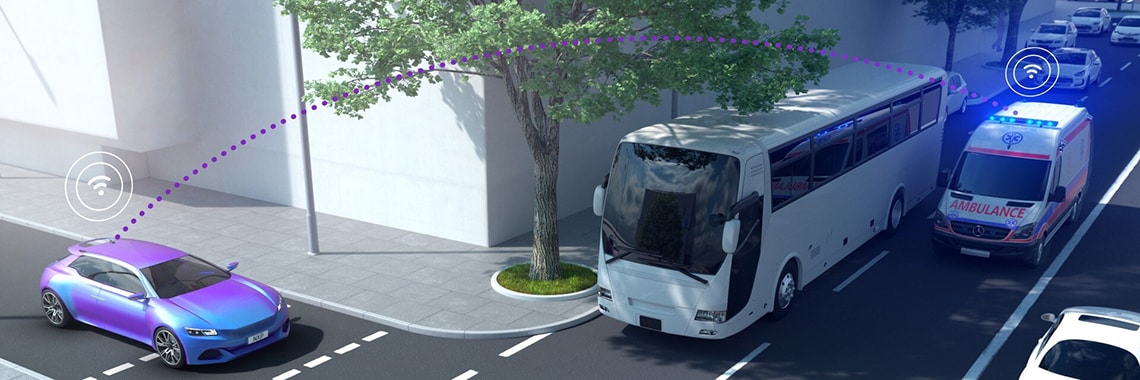Author

Rob Hoeben and Kees Moerman
Rob Hoeben, senior director of NXP's V2X business and NXP system architect, Kees Moerman, work in close collaboration to deploy NXP's V2X modem systems for a safer and greener world.

If you followed the discussions on the “Delegated Act” on Cooperative Intelligent Transport Systems (C-ITS) you probably noticed the EU Commission has finally published the regulation after years of debate. The Delegated Act is based on the ITS Directive 2010/40 EU which defines requirements for C-ITS stations and services.
As global #1 automotive semiconductor supplier and the largest European semiconductor company1, NXP is excited about this news. We are convinced that the Delegated Act is a crucial step towards safer roads and greener mobility, as it accelerates the adoption of vehicle-to-everything (V2X) technology. We are urging the co-legislators European Parliament and Council to support the Delegated Act in order to enable swift roll-out of C-ITS technology on European roads.
Why so?
Clear Technology Investments for Automakers
First of
all, this Delegated Act provides clarity around the technology to be used by
carmakers. It defines a hybrid approach, endorsing the ITS-G5 standard, also
known as IEEE 802.11p or DSRC, as the baseline technology for direct
vehicle-to-vehicle communication while using complementary 4G and 5G cellular
technology for longer range communication to infrastructure and cloud
services. The industry can now safely invest. It allows carmakers to start
line-fitting C-ITS technology into their cars so consumers can benefit from it
and road fatalities can be reduced significantly in the very near future
already.
Adaptable to Future Proven Advancements
Second, the
Delegated Act supports a multi-technology approach. While the current
technology for vehicle-to-vehicle communication is ITS-G5, there is provision
for new technologies to be adopted once they are mature and sufficiently field
tested. The current ITS-G5 technology has been maturing for the past years,
including first series production deployment already in the United States,
followed by a large EU carmaker who will line fit ITS-G5 by end of 2019.
Interoperability, Backwards Compatibility and Continuity
Third and furthermore, the Delegated Act ensures that any new ITS
applications and services would need to be interoperable, backwards compatible
and guarantee continuity with ITS-G5-based technology. The Delegated Act
avoids the risk of having a future patchwork of diverging, non-interoperable
solutions that significantly hampers road safety improvements. This is
essential, as all cars that over time will be equipped with C-ITS technology
need to be able to “talk to each other”, regardless of the
communication standard. This ad hoc communication ability is what makes the
driving safer.
NXP also has been involved in the evaluation of alternative standards for C-ITS, such as LTE-Vehicular (LTE-V) or Cellular-V2X (C-V2X). While cellular technology potentially could offer improved performance (moving to 5G-New Radio) and is often positioned as doing so already now, this does not materialise in the 4G Rel-14 standard of 3GPP (3rd Generation Partnership Project) to be used for Day-1 safety use cases. This was recently partly confirmed by the 5G Automotive Association (5GAA). The test results in the V2X Functional and Performance Test Report; Test Procedures and Results, published in October 2018, contained inaccurate information, as receive antenna diversity was not used. NXP appreciates that this was clarified in a formal letter to the Federal Communications Commission (FCC).
NXP strongly believes in the potential of ITS-G5 deployment for safety, augmented with 4G and 5G cellular connections in the future. Cellular connections can provide convenience use cases to consumers who are able to afford the monthly charges for that. It must be evident to all consumers in EU that the basic safety features are free of additional cellular charges.
In conclusion, NXP is convinced that the Delegated Act will enable carmakers to quickly adopt ITS-G5 technology in the EU market and start saving lives on our roads! It also offers new and mature technologies swift access to the market, allowing them to keep up with technological progress.
1 Source: Strategy Analytics 2017

Kees Moerman received his MSc in Physics and Computer Science in 1990 at the University of Utrecht, the Netherlands. He has 30+ years of experience in embedded systems and (signal) processors, especially in the domain of communications. He worked as chief architect, innovation manager and MT member in departments of several larger and smaller semiconductor companies, leading multi-domain specialist teams in the area of SoC communication systems. His current work is in the Automotive System Innovations group of NXP Semiconductors, on various communication technologies linked to Smart Mobility.

Rob Hoeben, senior director of NXP's V2X business and NXP system architect, Kees Moerman, work in close collaboration to deploy NXP's V2X modem systems for a safer and greener world.

Rob Hoeben, senior director of NXP's V2X business and NXP system architect, Kees Moerman, work in close collaboration to deploy NXP's V2X modem systems for a safer and greener world.

2020年6月19日
by Ross McOuat

2020年7月29日
by Davina Moore

2020年7月30日
by Jason Deal